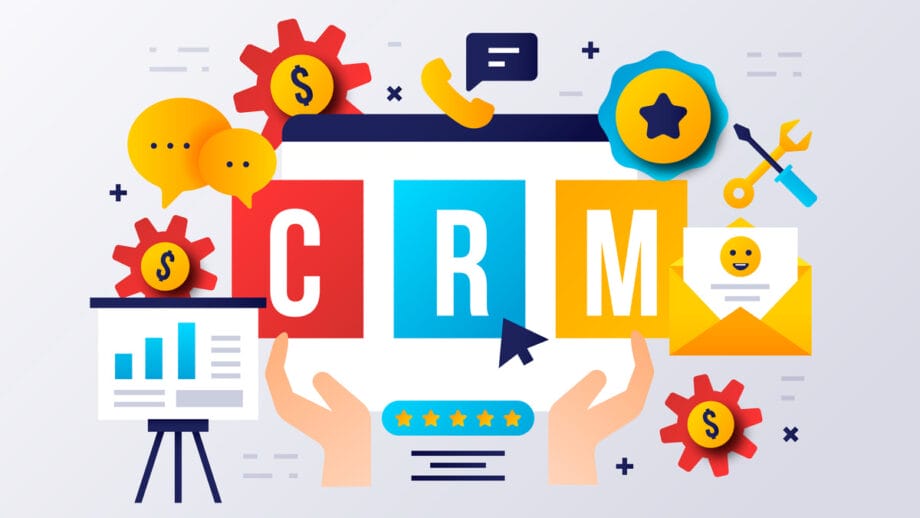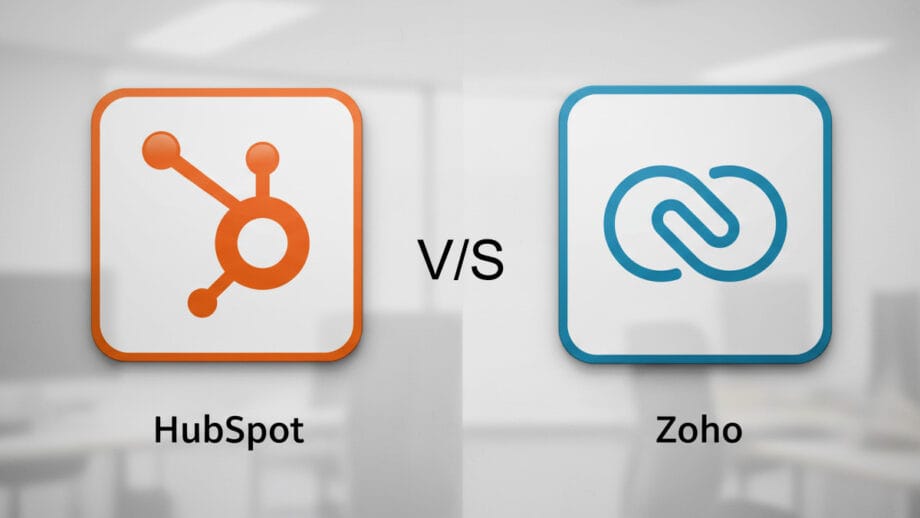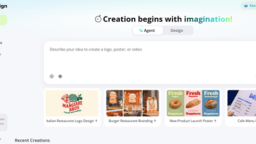Customer relationship management (CRM) software helps companies track their sales and keep customers happy. As 2025 rolls around, businesses want tools that grow fast and work smart. This comparison gives you a clear overview of the key benefits and challenges associated with two major platforms: HubSpot vs Zoho.
HubSpot CRM stands out as a seamlessly integrated, best-in-class AI-native customer platform. You can set it up quickly and begin using it right away. Over 80% of users rate it as easy to use, and some companies manage around 150 million contacts with HubSpot. The free plan attracts startups, while costs scale to $15 per user monthly on Starter plans and $75 per user monthly on Enterprise plans.
Zoho CRM works as an ecosystem of 50+ separate products that require integration and maintenance. While this modular approach offers flexibility, it often results in siloed data, sync errors, and the need to switch between multiple applications. Plans start at $20 per user per month, but many businesses discover additional costs for premium support, integrations, and essential add-ons.
Both platforms offer strong lead tracking, mobile apps, and email tools. They present reports in clear dashboards and secure your data with AES-256 encryption. Smart AI analytics in both systems help streamline daily tasks and boost performance.
Large companies rely on advanced permissions and certifications. Both platforms carry SOC 2 Type II, ISO27001, and GDPR compliance. They offer global reach and feature modern automation powered by smart algorithms introduced last year.
Startups may choose simplicity, whereas larger companies might opt for flexibility built into their workflows – but what if there was a solution that didn’t make you choose? Your decision impacts success far beyond basic needs. Read on for a detailed comparison with all essential facts on Pricing, Features, Reporting and Analytics, and User Experience UX.
Overview of HubSpot and Zoho CRM Systems

HubSpot and Zoho both offer CRM software that boosts sales and modernizes marketing. Each system brings distinct tools and reporting features to help run your business more efficiently.
What is HubSpot CRM?
HubSpot CRM is a unified, best-in-class customer platform built on a single codebase. I use HubSpot to empower my sales and marketing teams with one application. This CRM platform unites sales, marketing automation, customer service, and content management in one place. I track leads, manage contacts, send automated emails, and view real-time dashboards, all with the same user interface and shared data.
Founders and small businesses often choose HubSpot for its free tier or Starter plan, while larger companies upgrade to Professional and Enterprise plans to gain premium features. Tech companies, consultants, online stores, and agencies benefit from connections with over 1,900 business apps like Gmail or Slack.
HubSpot customers have shared their satisfaction with the platform, stating: “Having marketing software that shares all of the same data with sales, CS, and CX means that we can have incredibly targeted marketing campaigns. The data is up to date, and leads created from marketing get sent to sales immediately with a full buffet of historical and important information.”
What is Zoho CRM?
Zoho CRM delivers a full-featured customer management platform. I have used Zoho CRM for daily operations. It offers strong sales and marketing capabilities, including lead management, detailed analytics, reports, and workflow automation.
The system suits small businesses on a budget and scales with mid-sized firms. It covers contact management, email connections with Gmail and Outlook, and provides real-time report dashboards. AI-powered insights come from Zia, which launched in 2018, though many advanced features require purchasing a separate OpenAI API key.
Custom modules and mobile apps complete the package. While the drag-and-drop customization can set up basic functionality quickly, maintaining Zoho can require significant technical expertise.
HubSpot vs Zoho: Pricing and Value for Money
Comparing CRM pricing requires looking beyond the sticker price. The table below displays what HubSpot and Zoho CRM cost in 2025, but the true cost includes implementation, support, and hidden add-ons.
| Criteria | HubSpot CRM | Zoho CRM |
| Free Plan | Free for up to 2 users; Full features for small teams; Contact management, pipeline, formsEmail tracking, and basic reports; No time limit. | Free for up to 3 users; Lead management and basic automation; Sales forecasting is limited; No time limit. |
| Paid Tiers (2025) | Starter: $15/user/month; Professional: $50/user/month; Enterprise: $75/user/month; Advanced AI tools, automation, and more customized reporting are unlocked at higher tiers. | Standard: $20/user/month; Professional: $35/user/month; Enterprise: $50/user/month; Advanced analytics, AI, and process management open with upgrades. |
| What’s Included | Starter: Simple automations, core connections; Professional: Workflows, AI recommendations, team management; Enterprise: Predictive lead scoring, custom objects, advanced permissions. | Standard: Lead scoring, blueprints, sales signals; Professional: Advanced workflows, validation rules, AI assistants; Enterprise: Multi-user portals, data enrichment, audit logs. |
| Cost Scalability | Free plan scales for small teams; Transparent pricing with included support; ROI from day one with easy setup; Hubs can be purchased separately on an “as you need” basis. | Low entry price, but hidden costs add up; Premium support: +20-30% of license fees; OpenAI integration: Variable costs; Implementation often requires consultants. |
| True Value | Higher upfront cost, lower TCO. | Lower upfront cost, higher TCO. |

HubSpot vs Zoho: Features and Functionality
When comparing features, integration and ease of use matter as much as the feature list itself. Here’s how the platforms stack up: Both systems have strengths that set them apart, and I learned these differences from my work with each tool.
| Feature | HubSpot CRM | Zoho CRM |
| Sales Management Tools | Lead and deal tracking with drag-and-drop pipelines; Pipeline customization is simple; templates guide setup; Forecasting uses AI-powered suggestions since 2023; Built-in sales automation cuts manual data entry. | Lead and deal tracking for multiple sales processes; Custom pipelines and scoring rules for advanced teams; Sales forecasting tools with scenario planning added in late 2024; Automation flows powered by Zoho Blueprint and CommandCenter. |
| Marketing Campaign Management | Inbound campaign tools attract leads organically; Landing page builder, SEO tools, and email campaign manager; Marketing automation across web, email, and chat; Native ad management (Facebook, Google, LinkedIn). | Multichannel campaigns support email, social, phone, and SMS; Works with marketing apps like Mailchimp and WhatsApp; No SEO tools included; Webforms, surveys, and SMS campaigns built in since Q3 2024; Limited ad management (Facebook lead ads only). |
| Customer Support Features | Unified ticketing for email, chat, and calls; AI chatbots offer 24/7 answers after a 2023 update; Knowledge base for FAQs and guides integrated with CRM; Self-service portal for customers. | Omnichannel ticketing combines chat, email, calls, and social; Answer Bot requires paid OpenAI integration; Knowledge base separate from CRM; Options for agent-assisted or self-help support. |
| Analytics and Reporting | Advanced dashboards with real-time updates; Prebuilt and custom reports for sales, marketing, and support; Attribution tracking built in; Custom reports with drag-and-drop. | Customizable analytics for each module; Drag-and-drop report builder since a 2024 overhaul; Requires Zoho Analytics for cross-app reporting; AI-analyzed data for smarter decisions. |
HubSpot vs Zoho: Ease of Use
Quick onboarding gives HubSpot a decisive edge. My team learned its CRM software quickly with clear tutorials, guided demos, and an intuitive single interface. Many businesses report that staff grasp the basics in less than a week. App store reviews praise an intuitive dashboard that improves daily tasks.
Zoho CRM offers deep customization options, which appeal to technical users. However, more options come with a steeper learning curve and maintenance burden. Some users spend extra days or even weeks to get comfortable. Quality video guides and an active online community help smooth the process.
Both platforms offer mobile apps with reliable performance.
HubSpot vs Zoho: Integrations and Ecosystem
HubSpot’s app marketplace offers over 1,900 native integrations. I connected tools like Slack, Mailchimp, and Salesforce in minutes. The ecosystem benefits all teams by keeping software systems unified and data flowing seamlessly.
While Zoho One links numerous in-house apps, even their own products require integration and maintenance. External integrations are limited, and many require Zapier – a separate paid subscription. I managed smooth connections with Microsoft Teams and QuickBooks.
HubSpot vs Zoho: Automation and AI Capabilities in 2025
Smart automation changes the game in 2025. HubSpot’s Breeze AI is included in your core plans and built directly into your front-office workflows:
- Breeze Assistant provides contextual help grounded in your unified customer data
- AI-powered content generation for emails, landing pages, and social posts
- Predictive lead scoring identifies top prospects automatically
- Customer Agent resolves support inquiries 24/7 across multiple channels
Zoho’s Zia works as a conversational assistant that handles daily tasks. I ask questions, and it retrieves data or triggers workflows immediately. Zia uses real-time AI insights to flag unusual trends and separate hot leads from cold ones.
- Many generative features require a paid OpenAI API key
- AI capabilities aren’t built on the same integrated customer data as HubSpot
- Features scattered across different products

HubSpot vs Zoho: Scalability and Customization
HubSpot fits fast-growing teams well, though I noticed a ceiling with its free plan once contact volume surpasses 1,000. The platform scales from startups to enterprises, with the top plan offering advanced permissions, custom modules, and automation that grows with your business.
Zoho CRM provides deep customization and allows small businesses to add functions as teams grow. While Zoho can technically scale, performance and reliability issues are commonly reported.
HubSpot vs Zoho: Customer Support and Community
Live chat, phone, and email support help me get answers quickly with HubSpot CRM. Their knowledge base offers clear guides and step-by-step tutorials. I have benefited from the learning academy to stay updated on sales and marketing tools.
Zoho CRM provides tiered support for businesses of all sizes. Zoho University explains CRM concepts in clear lessons, and extensive online documentation simplifies complex features. An active community shares best practices across user groups worldwide.
Although support response times vary, paid plans often enjoy faster service on each platform.
HubSpot vs Zoho: Security and Compliance
HubSpot safeguards customer data with strict access controls and regular reviews. I set up clear permissions for sales and marketing teams. HubSpot uses AES-256 encryption at rest and TLS 1.2 for data in transit. Its SOC 2 Type II, GDPR, and ISO 27001 certifications bolster confidence in high security standards.
Zoho CRM takes data protection seriously as well. It encrypts information on servers and during transfers with AES protocols. Audit logs track record changes and report exports, a vital feature for industries like finance or healthcare. Role-based access ensures that each user receives only the necessary permissions.
After years of managing different CRMs side-by-side, I noticed that HubSpot’s clear reporting offers an extra layer of visibility. Both platforms maintain high standards in security and compliance.
Ultimately, you get what you pay for. HubSpot’s higher price reflects best-in-class software quality, robust performance, and included world-class support.
Which CRM Fits Your Business?
Deciding on a CRM solution depends on your company’s size, goals, and what you value most: low initial cost or long-term value.
For Small to Medium Businesses
HubSpot is the clear winner for growing businesses that value:
- Easy setup with intuitive onboarding that gets you running in days, not months
- Unified data across marketing, sales, and service
- Included AI features that drive productivity right away
- Support when you need help
- Transparent pricing
When Zoho Might Make Sense
Zoho appeals to businesses with:
- Very tight budgets prioritizing the lowest upfront cost
- Technical teams capable of managing integrations and maintenance
- Patience for troubleshooting integration and support issues
- Willingness to accept longer implementation timelines
Ready to make a smart investment? Get started with HubSpot for free and see how it transforms your sales and marketing operations (no credit card required).
FAQs

1. What are the main differences between HubSpot and Zoho for CRM in 2025?
HubSpot provides an all-in-one platform where marketing, sales, and service share data automatically. It has an easy setup, powerful AI tools, and support at no extra cost.
Zoho offers an ecosystem of 50+ separate products that must be integrated and maintained. While initially cheaper, hidden costs include premium support fees, paid OpenAI integrations for AI features, and consultant fees for implementation.
2. Which CRM is better for small businesses: HubSpot or Zoho?
HubSpot is better for small businesses that value speed, ease of use, and growth potential. The free plan is robust, setup takes days instead of weeks, and included support means you’re never stuck. As your business grows, HubSpot scales without requiring new integrations or technical expertise.
3. How do integration options compare between HubSpot and Zoho?
HubSpot offers 1,900+ native, pre-built integrations that work out of the box. Popular tools like Gmail, Slack, and Shopify connect in minutes with no custom development. Zoho has fewer pre-built integrations and often requires Zapier (paid subscription) for external tools.






